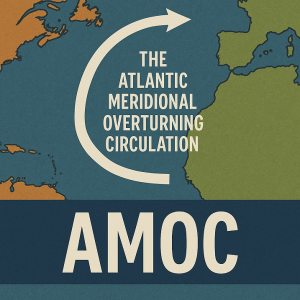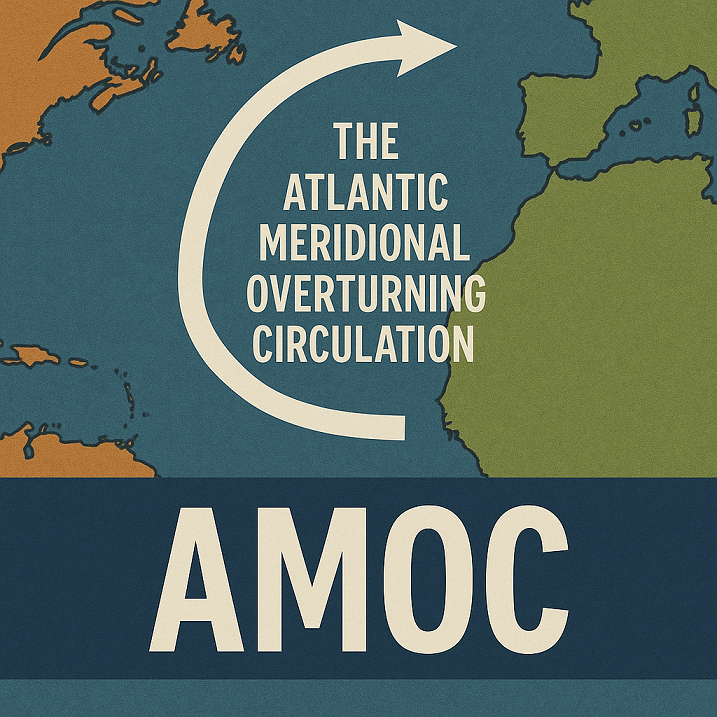 Explore the crucial role of the Atlantic Meridional Overturning Circulation (AMOC) in global climate and ocean health. Understand its impact on maritime trade, weather patterns, and coastal economies in this comprehensive, engaging guide.
Explore the crucial role of the Atlantic Meridional Overturning Circulation (AMOC) in global climate and ocean health. Understand its impact on maritime trade, weather patterns, and coastal economies in this comprehensive, engaging guide.
The Atlantic Meridional Overturning Circulation, or AMOC, is one of the most critical systems influencing Earth’s climate. It operates silently beneath the surface, transporting vast quantities of warm water from the tropics to the North Atlantic and returning cold water southward. Without it, the climates of many regions—including Europe, West Africa, and parts of North and South America—would be unrecognizable.
Yet AMOC is weakening.
According to the Intergovernmental Panel on Climate Change (IPCC), there is high confidence that the AMOC has slowed since the mid-20th century, and further weakening could significantly disrupt global climate, ocean ecosystems, and maritime activity (IPCC, 2021).
In this article, we dive deep into the mechanics of AMOC, its role in regulating climate and ocean conditions, and why maritime stakeholders must pay attention.
Why AMOC Matters in Modern Maritime Operations
At its core, AMOC is a massive conveyor belt of seawater. Warm surface currents, including the Gulf Stream, move northward, where they cool, become saltier, and sink in the North Atlantic. This cold, dense water then flows back toward the Southern Hemisphere at depth. This global engine of heat and salinity transfer drives ocean circulation patterns.
Why is this important for maritime industries?
- Shipping Routes: AMOC influences ocean currents and weather systems that affect shipping lanes. A weakening current alters prevailing winds, sea surface temperatures, and storm patterns.
- Fisheries: Species distribution is linked to ocean temperatures and nutrient cycling. If AMOC weakens, cold-water fish stocks like cod in the North Atlantic may decline or shift.
- Port Infrastructure: Rising sea levels and increased storm surges from changing AMOC patterns threaten coastal port infrastructure.
- Insurance & Risk Assessment: Underwriters and P&I clubs are increasingly modeling climate-related risk—and AMOC is a key variable (Lloyd’s Register, 2022).
Understanding the Science Behind AMOC
Oceanographers describe AMOC as a “thermohaline circulation” system, meaning it is driven by differences in temperature (thermo) and salinity (haline). It operates as part of the global ocean conveyor belt (also known as the Meridional Overturning Circulation or MOC).
When warm salty water from the tropics reaches higher latitudes, it cools and sinks in areas like the Labrador and Nordic Seas. This sinking motion pulls surface waters forward and drives a cycle that reaches into every major ocean basin.
This process plays a vital role in:
- Regulating climate in Europe and North America
- Distributing nutrients that support fisheries
- Absorbing carbon dioxide from the atmosphere
- Maintaining Arctic sea ice and regional precipitation patterns
According to NOAA, the AMOC moves nearly 20 million cubic meters of water per second. That’s roughly 100 times the flow of the Amazon River.
Key Signs AMOC Is Slowing Down
Scientists use proxies like deep-sea sediment cores, ice cores, and satellite altimetry to reconstruct historical AMOC activity. Over the past few decades, they’ve found:
- A 15% decline in AMOC strength since the 1950s (Caesar et al., Nature, 2018)
- Increased freshwater input from Greenland meltwater, disrupting salinity-driven sinking
- Shifts in the Gulf Stream extension, which is central to AMOC
- Greater heat content anomalies in the North Atlantic subpolar gyre
These indicators have led some models, including those used by DNV, to project a further decline of 30-50% by the end of the century under high-emissions scenarios.
Case Study: The North Atlantic “Cold Blob”
A striking anomaly that illustrates AMOC’s disruption is the so-called “cold blob” in the North Atlantic. Despite global warming trends, a patch of ocean south of Greenland has cooled significantly in recent decades.
This cooling is thought to be a result of reduced heat transport from a weakening AMOC. For shipping, this can mean unexpected ice formation, fog, and storm intensification along key North Atlantic routes, affecting vessels traveling from ports like Halifax, Boston, and Hamburg.
Impacts on Maritime Industries and Port Economies
Shipping and Navigation
A disrupted AMOC can change the very dynamics of the North Atlantic Oscillation (NAO) and even influence the frequency of Atlantic hurricanes. For maritime operators, this means increased voyage planning uncertainty.
Recent studies by Thetius and MarineTraffic note that irregular currents and extreme weather are already impacting fuel consumption and voyage times.
Fisheries and Coastal Livelihoods
Cold-water species may migrate north or vanish, while warm-water species encroach, altering traditional fisheries. Iceland, Norway, and parts of Canada have already documented cod population shifts linked to ocean temperature anomalies (Marine Policy Journal, 2021).
Infrastructure and Insurance
Ports like New York/New Jersey, Rotterdam, and Dakar face compound threats: rising sea levels, storm surges, and changing sediment transport. Dredging schedules, quay wall reinforcement, and insurance premiums are all being re-evaluated.
According to BIMCO, the need for adaptive port planning tied to climate risk is increasingly urgent.
Challenges and Solutions
The Freshwater Dilemma
Melting from Greenland and increased rainfall in the North Atlantic reduce salinity and density of surface water. This prevents proper sinking and stalls the overturning.
Solution: While we can’t “fix” AMOC directly, reducing greenhouse gas emissions under the IMO’s Initial GHG Strategy is critical. Ports can also play a role by transitioning to shore power, LNG bunkering, and low-emission logistics (IMO, 2023).
Monitoring and Data Gaps
Comprehensive, real-time monitoring of AMOC remains a scientific challenge.
Solution: Satellite systems (like those used by Inmarsat) and deep-sea moorings from NOAA, the UK Met Office, and EU Copernicus programs are filling these gaps.
New autonomous floats and AI-driven modeling by research institutions such as the WMU Journal of Maritime Affairs are helping predict AMOC-linked risks.
Port Adaptation Strategies
- Building elevated wharfs and sea walls
- Installing smart sensors for tidal and storm surge forecasting
- Investing in green infrastructure and buffer zones
ESPO (European Sea Ports Organisation) advocates integrating AMOC vulnerability in climate resilience assessments for all Atlantic-facing ports.
Future Outlook
The future of AMOC is uncertain, but the stakes are high. Some scientists warn of a possible tipping point, beyond which recovery may take centuries. While most models do not predict a full collapse this century, even a modest slowdown could:
- Accelerate sea level rise along the U.S. East Coast and West Africa
- Disrupt monsoons in South America and West Africa
- Alter the Atlantic hurricane season severity
- Lead to long-term cooling in Northern Europe, despite global warming
For maritime professionals, the challenge is to plan not just for one future, but for multiple plausible climate scenarios.
FAQ
What is AMOC in simple terms? AMOC is a system of ocean currents that move warm water from the tropics to the North Atlantic and return cold water southward at depth. It helps regulate global climate and ocean conditions.
Is the Gulf Stream part of AMOC? Yes. The Gulf Stream is a surface component of the broader AMOC system. It brings warm water north along the U.S. East Coast before veering toward Europe.
Why is AMOC slowing down? Melting ice from Greenland and increased rainfall reduce the salinity and density of water in the North Atlantic, hindering the sinking of water that drives the circulation.
How does AMOC affect ports and shipping? A weaker AMOC can lead to sea level rise, stronger storms, altered current patterns, and fish stock shifts—all of which affect port infrastructure, shipping lanes, and risk assessments.
Can AMOC collapse completely? While full collapse this century is unlikely, a partial weakening could still bring serious regional and global climate disruptions.
How are ports preparing for AMOC-related risks? By integrating climate models into infrastructure planning, raising sea walls, updating insurance policies, and investing in emission-reduction technologies.
What organizations monitor AMOC? NOAA, UK Met Office, EU Copernicus, and research institutions like the Alfred Wegener Institute and the University of Miami all contribute to AMOC monitoring.
Conclusion
The Atlantic Meridional Overturning Circulation may not be visible to the eye, but its impact is profound. From shifting fish stocks and altering trade winds to threatening ports and reshaping coastlines, AMOC is central to the maritime world.
Understanding and preparing for its changes is no longer optional. It’s essential for every maritime stakeholder—from ship operators and port authorities to regulators and insurers.
As the ocean currents change, so too must our strategies. AMOC might be slowing, but our response must accelerate.
References
- IPCC Sixth Assessment Report (2021) – https://www.ipcc.ch/report/ar6/wg1/
- Caesar et al., Nature (2018) – https://www.nature.com/articles/s41586-018-0006-5
- NOAA AMOC Resources – https://www.climate.gov/news-features/understanding-climate/climate-change-atlantics-overturning-circulation
- Lloyd’s Register (2022) – https://www.lr.org/en/insights/articles/sea-level-rise-and-insurance-liabilities/
- Marine Policy Journal (2021) – https://www.sciencedirect.com/journal/marine-policy
- IMO GHG Strategy (2023) – https://www.imo.org/en/OurWork/Environment/Pages/Greenhouse-Gas-Studies-2023.aspx
- BIMCO Climate Change Guidance – https://www.bimco.org
- ESPO Climate Adaptation Guidance – https://www.espo.be
- Inmarsat Maritime Monitoring – https://www.inmarsat.com
- MarineTraffic Analytics – https://www.marinetraffic.com
- Thetius Maritime Insights – https://www.thetius.com
- WMU Journal of Maritime Affairs – https://link.springer.com/journal/13437

